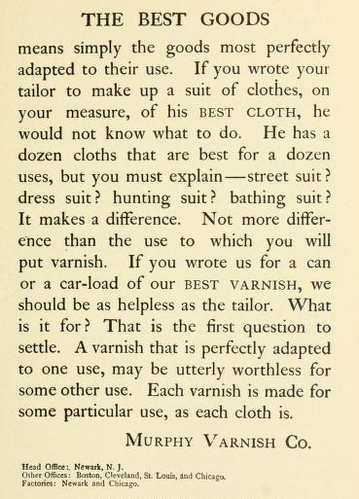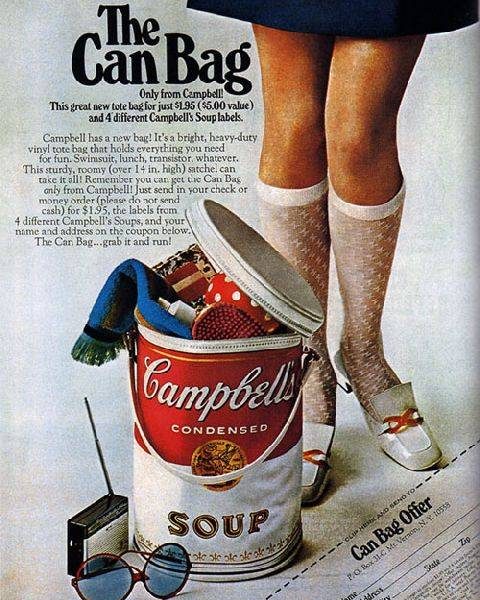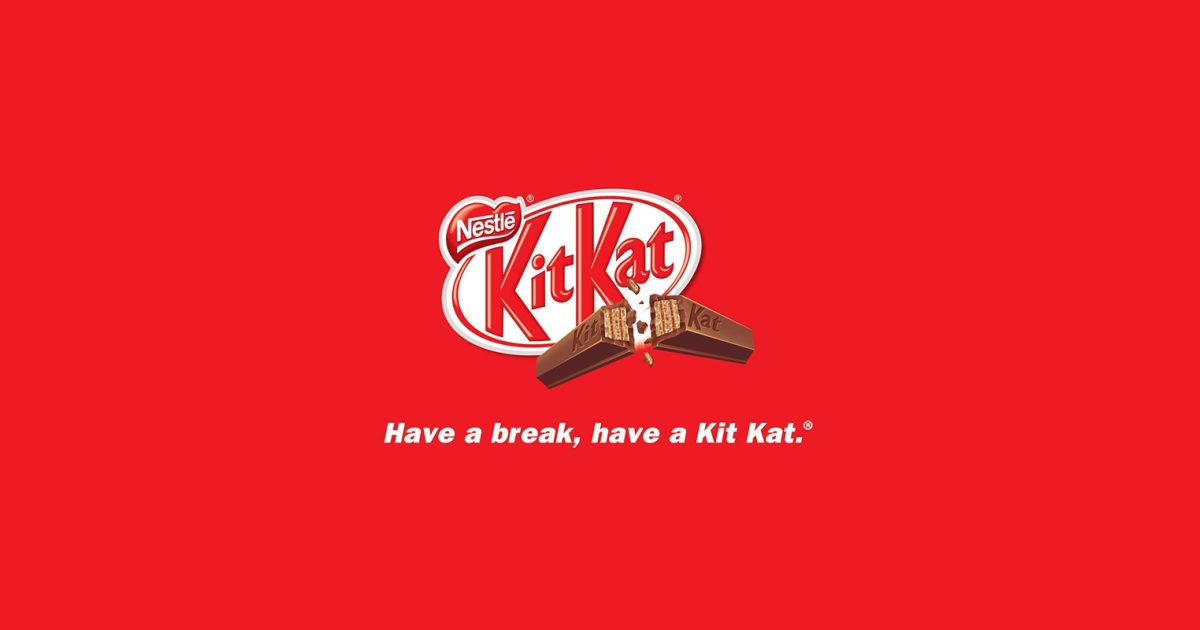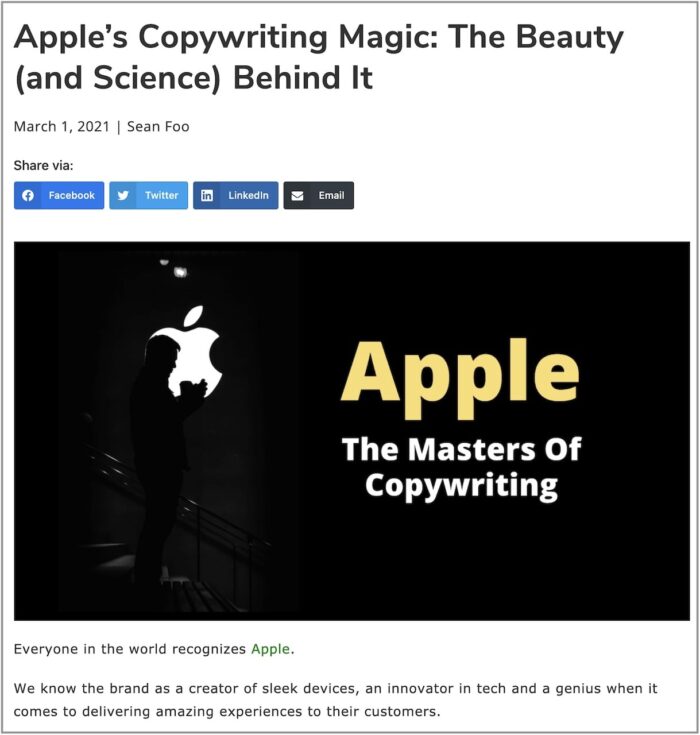Copywriting From A-Z: What It Is, Why It’s Important, and How To Get It Right
Image credit: Unsplash
Copywriting is everywhere these days.
From blogs to billboards, advertisements, press releases, social media captions, and more, copywriting is one of those things that’s so often in your face that it frequently gets overlooked. When the topic does pop up, it’s usually dismissed as the simple act of stringing a bunch of words together, or something that anyone can easily do.
After all, almost everyone in the business and marketing world is relatively literate, so what makes copywriting so special?
In addition to thinking copywriting is a simple process, another misconception a lot of people have about copywriting is that if you can write, you can write copy.
The truth is that although strong writing skills grant aspiring copywriters a considerable edge, writing copy professionally is a vastly different process than writing for a newspaper, or even for a book.
So, what is copywriting?
The Oxford Dictionary defines copywriting as the activity or occupation of writing the text of advertisements or publicity material.
Today, copywriting helps companies create, build, and maintain their identities, attract and educate customers, enhance their content for search engine optimisation (SEO), and more.
In line with what was mentioned above about copywriting being present almost everywhere and coming in a wide variety of different forms, it’s actually much more complex than many people think.
Today’s copywriters, particularly those in digital marketing agencies, have to be well versed in a variety of industries, mediums of communication, and formats. They require strong research, creative, communicative, interpersonal, technical, and problem solving skills in order to expand their portfolios, create effective and innovative content, play well with clients, and fulfill client objectives.
Why is it so important?

Image credit: Pexels
In tandem with the exponential growth and development of technology and the economy today, copywriting has expanded far beyond its roots of simple product advertisements.
Today, almost all businesses have some sort of digital presence, whether it’s their own social media platforms, websites, e-commerce sites, or all of the above. These platforms are used to either promote, provide information on, or sell their products to targeted audiences.
In order to stand out in today’s increasingly competitive market, brands have to place an emphasis on the continuous improvement of their digital marketing strategies. This involves a high level of creativity and innovation in terms of the strategies themselves, their visual impact, and you guessed it — copy!
Look at it like this: e-commerce and digital marketing have provided brands with digital storefronts.

Image credit: Instapage
This makes copywriters the sales associates of the digital marketing age — attracting customers and providing them with strategically delivered brand and product-related information that convinces them to make purchases.
What does good copywriting do for businesses?
When done right, great copywriting is exactly like an excellent sales pitch.
It ushers consumers through each stage of the marketing funnel:
- It brings awareness to unknowing consumers with search engine optimisation (SEO) and targeted content based on extensive market research.
- It stimulates interest and builds consideration by providing consumers with valuable insights via product education.
- It boosts intention by highlighting products’ unique selling points in an attractive manner.
- It encourages conversions, turning passive viewers into active customers by presenting brand promotions and product offerings in an appealing way.
- It inspires loyalty by strategically furnishing customers with avenues for engagement with brands.
- It cultivates customer advocacy by creating positive relationships between brands and their customers, influencing them to recommend products to others.
With all this in mind, it’s clear that copywriting is an integral part of the marketing process. It provides substance to marketing strategies and makes up the bulk of customers’ experiences with brands outside of the products themselves.
The origins of copywriting
Modern copywriting has had a fascinating evolution throughout history to become what it is today.

John Ayto, established etymologist and author of Dictionary of Word Origins.
Image credit: Amazon
The word ‘copy’ originated in the early 1300’s from the Latin word ‘copia’, which has to do with the concept of abundance. According to renowned etymologist John Ayto, the word had a secondary meaning, indicating ‘right’ or ‘power’, which ultimately led to its application as the ‘right to reproduction’, or simply ‘reproduction’.
The beginnings of copywriting were primarily announcements for the public from the church or governing bodies in large European cities. Before printing was invented, these posters were carefully handcrafted using quills and ink, and distributed in the street or attached onto walls or poles.
By the 1500s, with the advent of the printing press, the word ‘copy’ had evolved to indicate any sort of written or printed reproduction. Printing allowed the dissemination of text-based content on a mass scale. This enabled enterprising individuals and organisations to craft early forms of advertising content that could be distributed to a wide group of people, such as the ‘new advertisements’ in Benjamin Franklin’s Pennsylvania Gazette in 1729.

Front page of the Pennsylvania Gazette, 1729.
Image credit: Benjamin Franklin Historical Society
This newspaper was the first in history to have advertisers cover the cost of the paper’s production. This eliminated the cost to readers, which led to higher readership, more viewers for each piece of advertising, and more profit for businesses — a win-win situation for all parties involved.
In retrospect, this signalled the conception of the symbiotic relationship between copywriting and commerce and laid the groundwork for what we now know as the advertising industry.
Copywriting pioneers
The world’s first ever independent copywriter was a man named John Emory Powers in the 1800s. His first full-time position involved writing six advertisements a week for a department store called Wanamaker’s, doubling their yearly revenue within just nine months on the job.

Image credit: Wikipedia
Power’s colloquial, straight-talking writing style largely contributed to his professional success. He pioneered practices that today’s copywriters still adhere to, such as limiting his copy no more than 100 words to keep it concise.
By the 1890’s, Powers’ copy was in great demand from multiple well-known companies including Beecham Pills, Vacuum Oil, Scott’s Emulsion and Murphy Varnish.

Image credit: Wikipedia
Other notable copywriters include Robert Collier, an American writer who harnessed his understanding of human psychology to leverage on consumers’ emotions via direct mail advertisements in the 1930’s.

Image credit: Wikipedia
His renowned ‘Will You Do Me A Favour’ letters laid the blueprint for direct marketing today, establishing him as one of the most influential copywriters in history.
Copywriting beyond borders
The emergence of radio and television broadcasts culminated in the advertising renaissance of the 1960’s.
At this time, copywriting merged with pop art and photography to form visually driven, highly memorable advertising campaigns crafted by the marketing world’s first creative teams.

Advertisement for The Can Bag, a collaboration between Campbell’s Soup & Andy Warhol.
Image credit: NeatDesigns.net
Broadcasting also marked the beginnings of globalisation, which had a significant impact on the advertising and copywriting industries. All of a sudden, a single piece of brilliant copywriting- such as Volkswagen’s ‘Think Small’ campaign– could almost instantly reach international audiences and shape consumer perceptions across the globe.
This trajectory continued throughout the 1970’s and 1980’s until the arrival of the internet in the 1990’s. This would go on to change the face of marketing, and consequently, copywriting into what it is today.
The dawn of the digital age
One of the earliest examples of copywriting being used to entice internet users into engaging with a brand online was in 1994, when Wired magazine launched a website with an unprecedented marketing plan: internet advertising.
The website featured one the first ever clickable banner advertisements from communications company AT&T. It featured the words ‘Have you ever clicked your mouse here?’ with an arrow leading to the words ‘You Will.’
AT&T’s banner on Hotwired.com, 1994. Image credit: The Atlantic
By 1995, there were over 16 million internet users as well as plenty of businesses harnessing the power of the internet to attract and convert customers in new, innovative ways.
The impact of social media
The start of the 21st century saw yet another major shift in internet user and consumer behaviour. This is largely due to one of the most significant global phenomena to date: social media.
Image credit: Unsplash
Pioneering social media platforms such as MySpace (2003) were quickly adopted by internet users, paving the way for the social media giants of today such as Facebook (2004) and eventually, Twitter (2006), Instagram (2010), TikTok (2016), and more.
At this point, many consumers started researching brands and products online in order to make more informed purchase decisions- whether from peer review-based platforms or brands’ own websites and social media accounts.
Throughout the history of copywriting, there has been a running theme: whenever a new medium of communication pops up, copywriting follows. Naturally, copywriters are now finding themselves navigating the world of copywriting for social media and digital marketing.
What does copywriting look like today?

Image credit: Behance.net
At the present, copywriting takes on a multitude of different forms across a wide variety of channels. Although physical mediums such as billboards, flyers, newspaper advertisements, and magazines still exist, the bulk of modern marketing efforts has shifted into the digital world.
For the copywriters of today, a thorough knowledge of digital technology is a must. They have to be up to date with the latest cultural and social media trends and SEO (search engine optimisation) news, as well as multiple different formats and types of copy in order to produce relevant and effective work.
Types of modern copywriting include:
- Marketing copywriting
Image credit: Unsplash
Marketing copy encompasses the bulk of copy people see on a daily basis. It comes in a vast assortment of formats, from online advertisements, to flyers, video commercial scripts, billboards, and more.
However, no matter the form, all marketing copy shares a singular goal: to promote sales.
It does this by converting consumer awareness into interest by highlighting product benefits and unique selling points, and is an integral part of brands’ marketing campaigns and strategies.
- Social media copywriting

Image credit: eosproducts
Social media copy is presented on different platforms for different objectives depending on brand s’ requirements. As a result, it is often tailored to fit platform-specific limitations such as character limits, and incorporates social media elements such as hashtags to harness social media functionalities and enhance content to increase metrics such as reach and engagement.
It can sometimes be acceptable for social media copy to use relatively informal language and even emojis. The reason for this is that consumers are obviously viewing the content via social media, so it needs to have a strong relational aspect in order to engage its audience. Furthermore, it’s generally very visually driven, with the text either included within visuals themselves, created as captions for visuals, or both.
Typical goals of social media copywriting are to increase brand awareness, promote products, and educate consumers.
- Creative/Brand copywriting

Image credit: KitKat
Brand copywriting is centred around building brand awareness and establishing or reinforcing brands’ identities.
It can take the form of copy for brand slogans, ‘about’ or ‘our story’ pages, or even commercial jingles, such as Kit Kat’s ‘Have a break, have a Kit Kat’.
In order to be effective, brand copywriting needs to encompass the brand’s identity as a whole in a highly appealing way in order to create positive associations among its audience.
- Direct response copywriting

Image credit: Email Tuna
This sort of copy is designed with a simple aim in mind: to inspire specific and immediate action.
These actions can be anything from signing up for a mailing list to checking out a particular product, pre-loading a shopping cart before a big sale, or jumping on a limited-time offer.
In the context of the marketing funnel, direct response copy turns viewers’ desires into conversions with the inclusion of hard-hitting calls to action peppered with elements of urgency and/or exclusivity.
- Public relations copywriting
Image credit: PRNewsWire
Unlike most other forms of copy, public relations copywriting is not aimed directly to customers, but rather to media outlets.
Its purpose is to inform the press about a particular product, event, or campaign in order for them to push the information through various media channels to the public. This adds credibility to the content because it comes as a secondary opinion from a reputable source.
Public relations copy is typically written by public relations specialists, and can take the form of press releases, statements, or reports. They usually follow a specific format and have a slightly more formal tone than marketing or social media copy.
- Technical copywriting

Image credit: Lenovo
The goal of technical copy is to market products by explaining the technology behind them, such as when a skincare brand sells a moisturiser by explaining how its particular ingredients work to benefit the skin.
Essentially, it’s all about providing the audience with valuable insights via product education. Examples of technical copywriting include user guides, product descriptions, or educational blog posts and articles- much like this one!
The challenges involved with this kind of copywriting are mainly being able to translate complex technical concepts into text that’s easily digestible by the layman.
Consequently, in order to create effective technical copy, copywriters need to have pre-existing expertise on the technical aspects of the topics in question, or at least be willing and able to perform thorough research on them.
- Thought leadership copywriting

Image credit: SpeechSilver
Similarly to technical copywriting, one of the purposes of thought leadership copywriting is to educate the audience.
However, what sets thought leadership copywriting apart is that its primary focus is big-picture ideas concerning the industry as a whole (such as the direction in which a particular industry is heading, or major industry trends) as opposed to a particular product or technicality.
This content usually comes in the form of articles or research papers. It’s important that the content is extremely insightful and well-researched because its purpose is to convey a brand’s expertise in their field and establish their authority in their respective fields.
Target audiences for thought leadership are other businesses, industry figures, or consumers who are keen on getting in-depth information on a particular industry.
- SEO Copywriting

Image credit: Search Engine Journal
SEO (search engine optimisation) copywriting is designed to include strategic keywords and phrases to help it garner greater visibility on search engines. The higher the viewership, the more chances the brand has to achieve its objectives.
For example, a healthcare company might publish an article on its website about a particular disease, such as Parkinson’s.
An example of an SEO keyword for this might be ‘ways of treating Parkinson’s’, because it’s a term that someone seeking treatment for Parkinson’s might search online.
Once that person comes across the article, they’ll be able to access helpful information regarding the disease from an expert source, as well as access to the healthcare company’s contact or product information in case they want to make a purchase.
In addition to articles, SEO copy can come in the form of blog posts, web page copy, or online product descriptions.
The challenge that copywriters face with SEO writing is incorporating the designated SEO keywords or phrases into their copy without it seeming stilted or out of place.
However, when done well, SEO copy greatly benefits businesses by driving targeted traffic to branded content, all while making it feel like it was the viewer’s own idea to get there.
- Email copywriting
Image credit: Unsplash
An absolutely vital part of email marketing, email copywriting has the advantage of being delivered directly to its audience’s email inbox. The best part? The audience has already expressed interest in the product or service by joining the brand’s mailing list, so the message is pre-targeted.
Typical objectives of email copy are to educate the audience in the form of newsletters or updates, or to promote specific campaigns, product launches, or special offers.
Intrinsic elements of email copy include an eye-catching subject line and preview sentence, as well as a strong introductory sentence and compelling call to action.
The copywriting process
Regardless of the type of copy being created, there’s a general procedure that copywriters tend to follow in order to create effective content.
The following steps are a great launching pad for copywriters who are just getting started at their careers, or a helpful refresher for more experienced writers who want to review their writing process.
- Be prepared
Benjamin Franklin once said: ‘By failing to prepare, you are preparing to fail.’
Thorough research is the foundation of good copywriting. To establish credibility with their audience, copywriters need to demonstrate an astute understanding of the product or service in question.
Therefore, it’s crucial for copywriters to familiarise themselves with the ins and outs of the product they’re writing about as well as the brand itself in order to produce work that wins the trust of their audience while staying in line with the company’s values and identity.
Additionally, copywriters should also possess comprehensive knowledge of their target audience. The basic points to keep in mind include audience demographics such as age, gender, and income bracket, as well as their interests, cultural affinities, problems, and pain.
Once this information has been gathered, copywriters will have the means to effectively relate the product to the audience in a way that fits in seamlessly with the brand’s personality.
- Establish clear goals
After an information bank regarding the brand, product or service, and audience has been gathered, it’s time to determine how to use it.
Typically, the client will furnish a creative team with a brief, outlining their specific marketing objectives such as increasing reach, follower counts, engagement, or product education. They’ll also indicate the type of copy they need, such as an article, text for a landing page, or captions for social media posts.
As copywriters, the job here is to get an accurate understanding of what the final piece of content should accomplish. Whether it’s to attract attention, educate, promote, or reassure the audience, knowing the primary objective of the content helps copywriters structure their work accordingly.
- Structure your points
Once the content objective has been established, copywriters can start to compile all the necessary information required to achieve that objective.
Depending on the type of content, this can include points such as product descriptions and prices, key selling points, promotion deadlines, relevant links, SEO keywords, or calls to action.
It’s imperative that none of these points are left out so that the content has what it needs to accomplish its goal. We’d recommend making a list, then arranging it into an outline before proceeding to the next step- copy creation.
- Create your copy
Once the structure from the previous step in the copywriting process is in place, copywriters can expand on or paraphrase their points to make them presentable as a finished piece of copy.
When doing this, it can be helpful to review the first two steps of the process. Pick out valuable bits of information from the research process to capitalise on, such as unique product features, time-sensitive offers, or distinguished facts about the brand.
For example, if the brand has been nominated as a certain country’s top choice for a particular product, it may be worth mentioning in the copy to further entice the viewer.
Copywriters should also keep in mind what they know about their target audience’s preferred tone and language in order to keep the copy relatable and appealing.
For instance, if the audience belongs to a relatively young age bracket, using more informal vocabulary or even incorporating pop culture references into the copy can make a huge difference in how it’s perceived.
- Review and edit
Last but certainly not least, it’s paramount for copywriters to review their work for any grammatical, spelling, or content-related errors.
For instance, if the content is a contest announcement for a brand, all the dates, rules, and regulations have to be completely accurate. If the content is an SEO article, it has to include the required keywords.
Reading through, editing, and then repeating the process again helps ensure that all your copywriting i’s are dotted and t’s are crossed.
Throughout the editing process, another thing to look out for is brevity. A good rule of thumb here is to make every single word count towards achieving your content objectives. This can involve being a little ruthless, but in order to capture audiences’ increasingly short attention spans, it’s necessary.
Finally, when reviewing copy, writers should put themselves in their audience’s shoes and try to imagine how it would sound to them. Play around with different words and phrases, and don’t be afraid to embrace the number one secret weapon of copywriters around the globe: the online thesaurus.
Copywriting Do’s and Don’ts
Now that we’ve established the general steps of creating copy as well as the different kinds of copy that exist, here’s a helpful, actionable list of copywriting do’s and don’ts to help you understand what to look out for and what to avoid when it comes to writing or analysing copy.
Do:
- Know your audience
Although touched on before in this article, it’s worth mentioning again. A helpful tip for this is to create a fictionalised persona that represents your target audience, and write the copy in a way that relates to their problems and provides them with solutions.
Archant Hub has a great article where you can learn more about this in detail. Check it out here!
- Adjust your tone
When you know your target audience, you’ll be able to identify what kind of tone works to engage them. Also, keep in mind the objective of the copy- whether it’s to inspire excitement, urgency, admiration, or anything else- and choose your words accordingly.
- Have a clear structure
To retain the attention of a viewer, copy should have a clear, easy-to-follow structure that lures readers from point to point and strategically persuades them to act based on the content’s objectives.
- Establish an emotional connection
In order to craft copy that makes a lasting impact on the viewer, use language that appeals to the audience’s emotions. Discover more on how to create emotive copy in this great writeup by MarketSmiths.
- Make comparisons
If you’re trying to convince someone of something, it can be helpful to remind them of the negative consequences of the alternatives.
This can include describing inferior versions of the product from other brands, or undesirable situations they might face if they don’t own the product- and then presenting it as a desirable alternative.
For example, if the product is dairy-free milk, the copy can talk about how many milk alternatives are often bland or unhealthy, and then highlight the taste and nutrient-rich ingredients of the product itself.
- Incorporate action verbs
No matter how informative or well-written a piece of copy is, sometimes you need to give viewers a little nudge in order for it to garner actual results.
These copywriting magic words are keys to inspiring your audience to act on your message. They create a sense of urgency and leverage on humans’ deep-seated fear of missing out.
- Include proof
Image credit: Unsplash
Including hard evidence of the product or service’s efficacy such as statistics and survey results adds credibility to your copy, reassuring viewers that they aren’t being duped with false promises.
Just make sure to link it to a tangible, personalised benefit in order to illustrate your point to the audience.
- Anticipate doubts and objections
Today’s consumers have developed strong mental barriers against promotional content due to the sheer amount of it they see on a daily basis.
In order to overcome these barriers and create copy that convinces even the most cynical consumer, demonstrate empathy to their grievances and offer solutions for any concerns they may have regarding the product in your copy.
- Illustrate products as positive experiences
Purchase decisions are largely driven by emotion rather than practicality.
Although the material benefits of a product should be demonstrated in marketing content, what makes it truly engaging is when it demonstrates the ability to satisfy consumers’ needs and fulfill their desires.
We’d recommend using Abraham Maslow’s hierarchy of needs to help you match products’ practical functions with their more abstract benefits. This will add a powerful extra dimension to your copywriting process and make it far more effective.
Don’t:
- Skimp on the review process
One can never be too careful about the little details when it comes to copywriting- especially when clients are involved. The smallest oversight, such as an extra zero in a price point or an incorrect date, can have significant consequences on the brand. Naturally, the blame will fall on the one who crafted the content.
If you manage your time well, you’ll be able to take a step back from your work and read it over with fresh eyes.
In addition to helping you catch any inaccuracies, this can help trigger better ideas for a more polished final product, such as a smoother way to structure a sentence, or a more appropriate word for something.
- Be overly technical
One of the toughest challenges in copywriting is simplifying complex, industry-related terms and concepts into copy that everyday consumers can not only comprehend, but engage with.
When writing about more complicated products and services, avoid using jargon and technical language as much as possible.
Instead, focus on the bottom-line benefits to customers, such as increased convenience or performance, and then tie them back to the product in as conversational a manner as possible.
- Exaggerate
When trying to create impactful content, it can be tempting to inflate certain aspects of the product or service in order to make it seem more appealing. We’re here to remind you: don’t do it!
Today’s consumers are placing an increasing importance on brands’ trustworthiness and ethics when it comes to making purchase decisions. Drawing in customers with false promises can not only damage public opinion in the long run, but even create legal ramifications.
Instead of taking a shortcut that might come back to haunt you eventually, be strategic in the way you select your words and focus on the existing selling points of what you’re writing about. The results will come naturally from there.
- Be cliche

Image credit: Pexels
In today’s highly saturated marketplace, originality is in short supply. Consumers are growing desensitised to the same old sales pitches and strategies, so coming off as a carbon copy of the industry standard is often ineffective.
Invest your time in finding inspiration where you can, and trust in your own creativity and intuition to help you find fresh angles to present your message. This will take your skills to another level, helping you set trends instead of getting stuck chasing them.
Elements of incredible copy
Now that we’ve established how to create copy that gets the job done, here are some more subjective things to reflect on that will help you take your copywriting skills to the next level.
- Connection
Human beings are social creatures, which makes relationships tremendously influential factors for decision making.
This type of consumer behaviour is probably something you demonstrate yourself, whether it’s revisiting a longtime family doctor, or supporting a restaurant that belongs to a good friend.
To win audiences over, build connections by speaking to and treating them as human beings as opposed to just another faceless consumer.
- Urgency
It’s part of human nature to procrastinate, especially when it comes to making decisions. How many times have you eagerly added a bunch of items to an online shopping cart, then abandoned it because you can’t decide whether or not it’s all worth it?
To convert otherwise passive viewers, think of what triggers your own self to act when you feel this way. Typically, it’s things like time sensitivity or scarcity that inspire a sense of urgency in audiences and stimulate them to pick a course of action.
- Reciprocity
Respect is a two-way street. In order to make your audience trust you, want to engage with you, and be loyal to you, you have to in turn cultivate integrity, strive to build solid relationships, and maintain a high standard of quality.
- Transformation
You can describe something in an incredibly alluring or catchy way, but if the audience doesn’t have a distinct idea of how it can directly benefit them, nothing will come of it.
For instance, consider the title of this article.
On its own, ‘Copywriting From A-Z’ sounds like the title of a really boring encyclopedia. However, including a short line that clearly conveys the overarching purpose of the article gives you an immediate sense of what you’ll stand to gain from reading it.
- Belonging
Truly great copywriting demonstrates a holistic understanding of consumer psychology. At the end of the day, people possess an inherent desire to be part of something bigger than themselves.
Some people purchase healthy food and supplements because they want to be a part of a health-conscious community. Others purchase luxury items because they hope to fit into an exclusive tier of society.
Whatever your product, when you can harness that desire in relation to what you’re trying to achieve with your copy, you’ll not only be able to engage your audience, but create lasting positive relationships with them.
Final thoughts
We hope this article has helped you understand what an invaluable tool copywriting is!
Copywriting brings the strategies digital marketing agencies and brands create to life, acting as the voice for businesses to reach out to consumers, form their identities, and forge lasting bonds with key audiences.
Here at Social Grooves, we combine concerted creative efforts with a technologically progressive edge to generate content that benefits brands not only in the short term, but in the long run- an approach that has empowered us in our journey to becoming one of the top digital marketing agencies in Malaysia.
If you’re interested in creative solutions to help your company flourish in the digital marketing landscape, drop us an email at ask@socialgrooves.com today!






